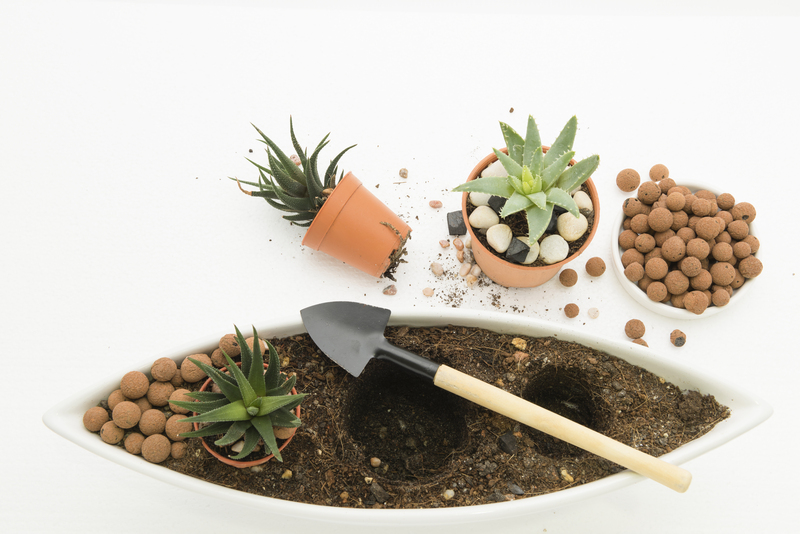Comparing Chemical and Manual Tree Stump Removal Options: A Comprehensive Guide
When you have a tree removed from your yard, you're often left with a stubborn stump that can detract from your landscape's beauty and even pose a tripping hazard. Tree stump removal is an important step in landscaping, home improvement, or gardening projects. But which is best: chemical stump removal or manual stump removal? In this in-depth article, we'll compare chemical and manual tree stump removal methods, exploring the pros, cons, cost, safety, and best practices for each approach.
Understanding Tree Stump Removal
Removing a tree stump requires careful planning and the right technique. There are two main options homeowners and professionals typically consider:
- Manual (or mechanical) stump removal
- Chemical stump removal
Each method has its unique characteristics, costs, labor requirements, environmental effects, and timeline for completion.
Why Remove a Tree Stump?
- Aesthetics: Old stumps are often unsightly and can ruin the look of your garden or yard.
- Prevention of New Growth: Leftover stumps can sometimes sprout new shoots, leading to unwanted growth.
- Safety: Stumps can be tripping hazards for children, pets, and adults.
- Pest Prevention: Decaying stumps attract insects like termites, beetles, and ants, which can migrate to nearby healthy trees or your home.
- Space Optimization: Removing stumps opens up room for planting new trees, shrubs, or gardens.

Manual Tree Stump Removal: Methods, Advantages, and Drawbacks
What is Manual Stump Removal?
Manual or mechanical stump removal involves physically extracting the stump from the ground. This can be done using hand tools, powered machines, or a combination of both. Among the most popular manual techniques are:
- Digging and Chopping: Using shovels, axes, and mattocks to break up and extract the stump and major roots.
- Stump Grinding: Employing a specialized power tool that uses a rotating cutting disc to grind the stump below ground level.
- Pulling Out: Using winches, chains, or even small machinery to pull entire stumps out of the earth (best for smaller stumps and shallow-rooted trees).
Advantages of Manual Tree Stump Removal
- Immediate Results: Manual removal often gives instant gratification, especially with stump grinding or pulling methods.
- Completely Removes the Stump: When done correctly, this method eliminates the stump and most major roots, reducing chances for regrowth.
- Eco-Friendly: No chemicals are needed, which means there's no risk of soil or water contamination.
- Prepares the Area for Immediate Use: As the material is removed, you can directly replant, reseed, or landscape the spot.
Disadvantages of Manual Stump Removal
- Labor-Intensive: Manual removal, especially digging and chopping, can be physically demanding and time-consuming, particularly for large or old stumps.
- Potential for Property Damage: Heavy equipment like grinders can damage surrounding turf or landscape features if not used carefully.
- Cost: Professional mechanical stump removal (especially stump grinding) can be **expensive** if you hire a specialist. Renting equipment adds to DIY costs.
- Not Suitable for All Stump Sizes: Deep-rooted or very large stumps may require professional machinery or may not be feasible for hand removal.
Best Practices for Manual Stump Removal
- Clear the Area: Remove rocks and debris around the stump before starting work.
- Safety Gear: Always wear protective equipment, including gloves, goggles, and sturdy boots.
- Right Tools: For hand removal, use sharp axes, a sturdy shovel, and a mattock. For grinding, ensure you are trained in the use of the equipment.
- Plan for Disposal: Make arrangements for wood chips or large stump pieces after removal.
Chemical Tree Stump Removal: Process, Pros, and Cons
What is Chemical Stump Removal?
Chemical stump removal involves applying specialized chemical stump removers (often containing potassium nitrate) to accelerate the decay of the wood. Over weeks or months, the stump softens and becomes easier to break up or remove.
- Drilling Holes: Deep holes are drilled into the top and sides of the stump to maximize chemical penetration.
- Applying Chemical Solution: Pouring a stump remover powder, granules, or liquid into the holes.
- Allowing Time to Decompose: It may take several weeks to months for the stump to soften sufficiently.
- Physical Removal: After decomposition, the soft stump is removed with an axe, shovel, or burned (if allowed by local regulation).
Advantages of Chemical Stump Removal
- Low Physical Effort: Minimal heavy lifting or digging required.
- Cost-Effective: Chemical stump removers are widely available and usually inexpensive.
- Accessible to Homeowners: Perfect for those without access to specialized stump removal equipment or who prefer DIY methods.
Disadvantages of Chemical Stump Removal
- Time Consuming: Stump decomposition can take several weeks or months, meaning results are far from immediate.
- Chemical Risks: Potential for toxic runoff, soil contamination, or harm to pets, wildlife, and children if chemicals are improperly applied.
- Incomplete Removal: Deep or broad root systems may not completely decay, occasionally leading to partial regrowth.
- Not Optimal for Large Stumps: Big hardwood stumps may take years to break down via chemicals.
Best Practices for Chemical Stump Removal
- Follow Manufacturer Instructions: Always use chemicals as directed for safety and effectiveness.
- Monitor the Area: Keep children and pets away from the treated stump until decomposition is complete.
- Comply with Local Laws: Burning softened stumps may not be legal in some neighborhoods or towns.
- Environmental Precautions: Avoid runoff into waterways and protect desirable plants from chemical exposure.
Manual vs. Chemical Tree Stump Removal: Which Is Right for You?
Key Factors to Consider
- Stump Size and Type: Larger, older, or hardwood stumps may be more efficiently tackled with manual grinding or pulling, while smaller or softwood stumps can often be treated chemically.
- Time Frame: Those needing immediate results should opt for manual techniques; chemical methods require patience.
- Physical Ability: DIY chemical stump removal is ideal for people who want to avoid strenuous labor.
- Budget: Chemical removers are less expensive than hiring professionals for mechanical grinding, though renting grinders can lower costs for DIYers.
- Environmental Concerns: If you are worried about chemicals leaching into your garden, manual removal is preferable.
- Follow-up Plans: For areas destined for immediate landscaping or building, manual removal is a better choice as it leaves the ground ready for use.
Table: Comparing Chemical and Manual Stump Removal Options
| Criteria | Manual Stump Removal | Chemical Stump Removal |
|---|---|---|
| Time to Completion | Immediate to a few hours/days | Weeks to months |
| Physical Effort | High | Low |
| Cost | Moderate to High (if hiring professionals) | Low |
| Equipment Needed | Tools or machinery | Drill, chemicals, water |
| Environmental Impact | Low | Moderate (chemical exposure) |
| Results | Complete removal | Gradual decomposition; roots may remain |
DIY vs. Professional Tree Stump Removal
*Should you hire a pro or handle the job yourself?* When comparing chemical and manual tree stump removal options, factor in your skill level, available equipment, and time commitment.
- DIY Manual Removal: Most suitable for small to medium-sized stumps in accessible areas; requires strength, the right tools, and often teamwork.
- DIY Chemical Removal: Great for patient DIYers tackling smaller or older stumps not close to waterways, edible gardens, or play areas.
- Professional Help: Contractors or tree service companies typically handle large, complex, or hazardous stump removals using grinding machines or excavation equipment.
Environmental and Safety Considerations
Both stump removal methods carry important safety and environmental issues:
- Personal Safety: Manual work can result in injury without proper gear and technique. Chemicals should be stored and applied safely to prevent poisoning or burns.
- Local Regulations: Some municipalities restrict burning of stumps, chemical use, or require permits for certain removal techniques.
- Soil and Water Health: Chemicals can leach into the soil and contaminate groundwater. Always err on the side of caution near gardens, wells, or streams.
- Disposal of Debris: Plan ahead for cleanup--rotten wood and root debris may require special handling.
Summary: Which Tree Stump Removal Method Is Best?
The best choice for removing a tree stump depends on your priorities, project size, budget, and time constraints. Manual stump removal is fast, thorough, and eco-friendly but often expensive or labor-intensive. Chemical stump removal is easy and inexpensive but slow and occasionally less effective for large stumps.
For most homeowners aiming for fast, complete removal (especially for landscaping or construction projects), **manual methods** are superior. If you're not in a hurry and dealing with smaller or old stumps, chemical solutions offer a less demanding, budget-friendly option.
Whichever method you choose, always follow recommended safety and environmental practices. For tough or risky jobs, don't hesitate to consult or hire a certified arborist or professional stump removal contractor.

Frequently Asked Questions About Tree Stump Removal
- How long does chemical stump removal take?
Most chemical methods take from four weeks to six months, depending on the size and type of stump. - Is manual stump removal environmentally safe?
Yes, as manual removal does not introduce harmful substances into the soil, making it ideal for gardens and areas near water sources. - Will the tree grow back after stump removal?
When the entire stump and major roots are removed, regrowth is unlikely. Chemical removal may leave roots that sometimes resprout. - Can I burn the stump after chemical softening?
Only if permitted by local law. Always check municipal codes before attempting to burn stumps.
Conclusion: Making the Right Choice for Tree Stump Removal
In comparing chemical and manual tree stump removal options, each comes with its own set of advantages and drawbacks. Manual removal is rapid and effective, best for those needing quick results, while chemical removal is suited for patient DIYers and smaller stumps. Evaluate your site, schedule, physical abilities, and environmental concerns to choose the most suitable method. When in doubt, consult a pro for guidance on safe and efficient tree stump removal.
Ready to reclaim your landscape? Choose the tree stump removal method that matches your needs and get started today!



